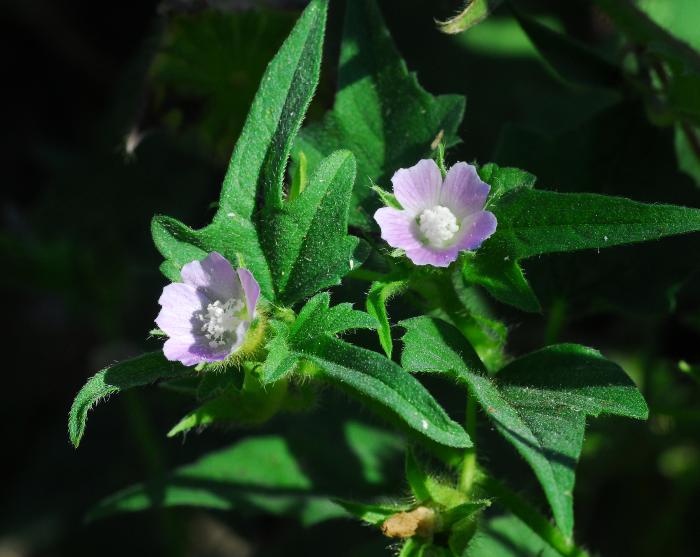Anoda cristata (L.) Schltdl.
Spurred Anoda

Introduced
CC = *
CW = 3
MOC = 15
© SRTurner
Anoda cristata (L.) Schltdl.Spurred Anoda | |
 |
Introduced CC = * CW = 3 MOC = 15 |
© SRTurner |
|
Family - Malvaceae Habit - Annual forb. Stems - To 1 m, sprawling or loosely ascending, pubescent with pustular-based hairs.
Leaves - Long-petiolate, simple, highly variable in shape, variously lobed, hastate, ovate, irregularly toothed or scalloped, surfaces pubescent with loosely appressed hairs. Stipules 6-10 mm long, linear, persistent.
Flowers - Calyces 5-10 mm long at flowering, enlarged to 20 mm long at fruiting, the sepals fused to about the middle, the lobes narrowly lanceolate-triangular at flowering, becoming broadly triangular at fruiting, the outer surface pubescent with spreading pustular-based hairs. Petals 8-12 mm long, lavender, rarely white, often drying blue. Stamens numerous, the staminal column circular in cross-section, the anthers white or light bluish purple. Pistils with 8-18 locules, the carpels arranged in a loose, strongly flattened ring. Styles fused most of their length, each branch with a globose terminal stigma.
Fruits - Schizocarps breaking into 8-18 mericarps. Mericarps 2-4 mm long, wedge-shaped, pubescent with spreading pustular-based simple hairs, the dorsal surface green, with a prominent horizontally spreading beak, oblong to kidney-shaped in profile, 1-seeded. Seeds 3-4 mm long, oblong-rectangular to kidney-shaped, the surfaces minutely pebbled or warty, black or dark brown.
Flowering - June - September. Habitat - Agricultural fields, floodplains, ditches, open disturbed areas. Origin - Native to the southwestern U.S. Other info. - This attractive little species is fairly uncommon in Missouri. It seems to be waiflike, popping up unexpectedly, persisting for a time, and then disappearing. In some cases, its presence in crop fields may be due to the presence of its seeds as a contaminant in agricultural seed stocks. It is a troublesome agricultural weed in some parts of the U.S., particularly in soybean fields. Photographs taken in Weldon Spring Conservation Area, St. Charles County, MO, 10-9-2011 (SRTurner). |